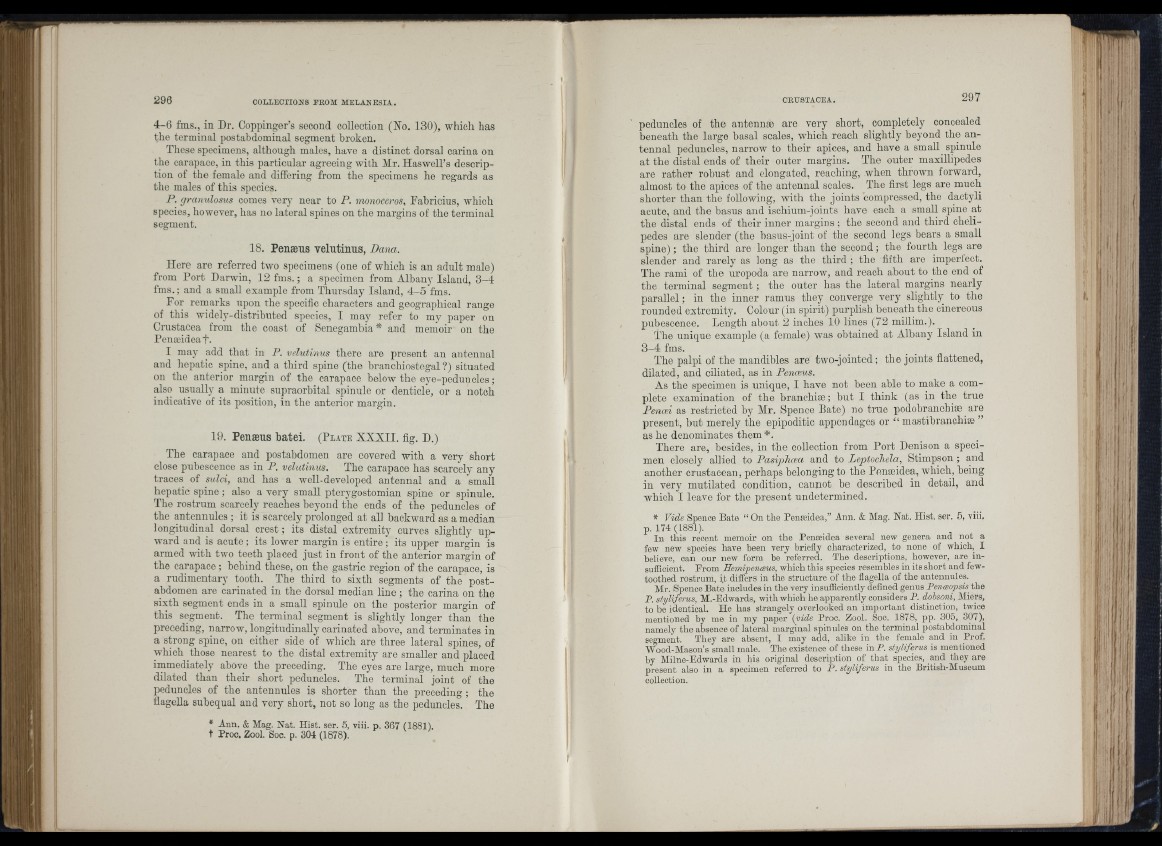
4 -6 fms., in Dr. Coppinger’s second collection (No. 130), which has
the terminal postahdominal segment broken.
These specimens, although males, have a distinct dorsal carina on
the carapace, in this particular agreeing with Mr. Haswell’s description
of the female and differing from the specimens he regards as
the males of this species.
P. granulosus comes very near to P. monoceros, Fabricius, which
species, however, has no lateral spines on the margins of the terminal
segment.
18. Penæus velutinus, Dana.
Here are referred two specimens (one of which is an adult male)
from Port Darwin, 12 fms.; a specimen from Albany Island, 3 -4
fms. ; and a small example from Thursday Island, 4 -5 fms.
For remarks upon the specific characters and geographical range
of this widely-distrihnted species, I may refer to my paper on
Crustacea from the coast of Senegambia* and memoir on the
Penæideaf.
I may add that in P. velutimis there are present an antennal
and hepatic spine, aud a third spine (the hranchiostegal ?) situated
on the anterior margin of the carapace below the eye-peduncles ;
also usually a minnte supraorbital spinule or denticle, or a notch
indicative of its position, in the anterior margin.
1 9. Penæus batei. ( P l a t e X X X II. fig. D.)
The carapace and postahdomen are covered with a very short
close pubescence as in P. velutinus. The carapace has scarcely any
traces of sulci, and has a well-developed antennal and a small
hepatic spine ; also a very small pterygostomian spine or spinule.
The rostrum scarcely reaches beyond the ends of the peduncles of
the antennules ; it is scarcely prolonged at all backward as a median
longitudinal dorsal crest ; its distal extremity curves slightly upward
and is acute ; its lower margin is entire ; its upper margin is
armed with two teeth placed just in front of the anterior margin of
the carapace ; behind these, on the gastric region of the carapace, is
a rudimentary tooth. The third to sixth segments of the post-
abdomen are carinated in the dorsal median line ; the oarina on the
sixth segment ends in a small spinule on the posterior margin of
this segment. The terminal segment is slightly longer than the
preceding, narrow, longitudinally carinated above, and terminates in
a strong spine, on either side of which are three lateral spines, of
which those nearest to the distal extremity are smaller and placed
immediately above the preceding. The eyes are large, much more
dilated than their short peduncles. The terminal joint of the
peduncles of the antennules is shorter than the preceding ; the
flagella subequal and very short, not so long as the peduncles. The
* Ann. & Mag. Nat. Hist. ser. 5, viii. p. 367 (1881).
t Proc. Zool. Soc. p. 304 (1878).
J :
peduncles of the antennæ are very short, completely concealed
beneath the large basal scales, which reach slightly beyond the antennal
peduncles, narrow to their apices, and have a small spinule
at the distal ends of their outer margins. The outer maxillipedes
are rather robust and elongated, reaching, when thrown forward,
almost to the apices of the antennal scales. The first legs are much
shorter than the following, with the joints compressed, the dactyli
acute, and the basus and ischium-j oints have each a small spine at
the distal ends of their inner margins ; the second and third chelipedes
are slender (the hasus-joint of the second legs bears a small
spine) ; the third are longer than the second ; the fourth legs are
slender and rarely as long as the third ; the fifth are imperl'ect.
The rami of the uropoda are narrow, and reach about to the end of
the terminal segment ; the outer has the lateral margins nearly
parallel ; in the inner ramus they converge vory slightly to the
rounded extremity. Colour (in spirit) purplish beneath the cinereous
pubescence. Length about 2 inches 10 lines (72 millim.).
The unique example (a female) was obtained at Albany Island in
3 -4 fms.
The palpi of the mandibles are two-jointed; the joints flattened,
dilated, and ciliated, as in Penæus.
As the specimen is unique, I have not been able to make a complete
examination of the branchiæ ; but I think (as in the true
Pencd as restricted by Air. Spence Bate) no true podobranchiæ are
present, but merely the epipoditic appendages or “ mastibranchiæ ”
as he denominates them *.
There are, besides, in the collection from Port Denison a specimen
closely allied to Pasiphoea and to Leptochela, Stimpson ; and
another crustacean, perhaps belonging to the Ponæidea, which, being
in very mutilated condition, cannot be described in detail, and
which I leave for the present undetermined.
Vide Spence Bate “ On the Penæidea,” Ann. & Mag. Nat. Hist. ser. 5, viii.
p. 174 (1881).
In this recent memoir on the Penæidea several new genera and not a
few new species have been very briefly characterized, to none of which,^ I
believe, can our new form be referred. The descriptions, however, are in-
suiflcient. From Hemipenæus, which this species resembles in its short and fewtoothed
rostrum, it differs in the structure of the flagella of the antennules.
Mr. Spence Bate includes in the very insufficiently defined genus Penæopsis the
P. styliferus, M.-Edwards, with which he apparently considers P. dohsmii, Miers,
to be identical. He has strangely overlooked an important distinction, twice
mentioned by me in my paper {vide Proc. Zool. Soo. 1878, pp. 305, 30/),
namely the absence of lateral marginal spinules on the terminal postahdominal
segment. They are absent, I may add, alike in the female and in Prof.
Wood-Mason’s small male. The existence of these in P. styliferus is mentioned
by Milne-Edwards in his original description of that species, and they are
present also in a specimen referred to P. styliferus in the British-Museum
collection.
9 i î :M
i'il